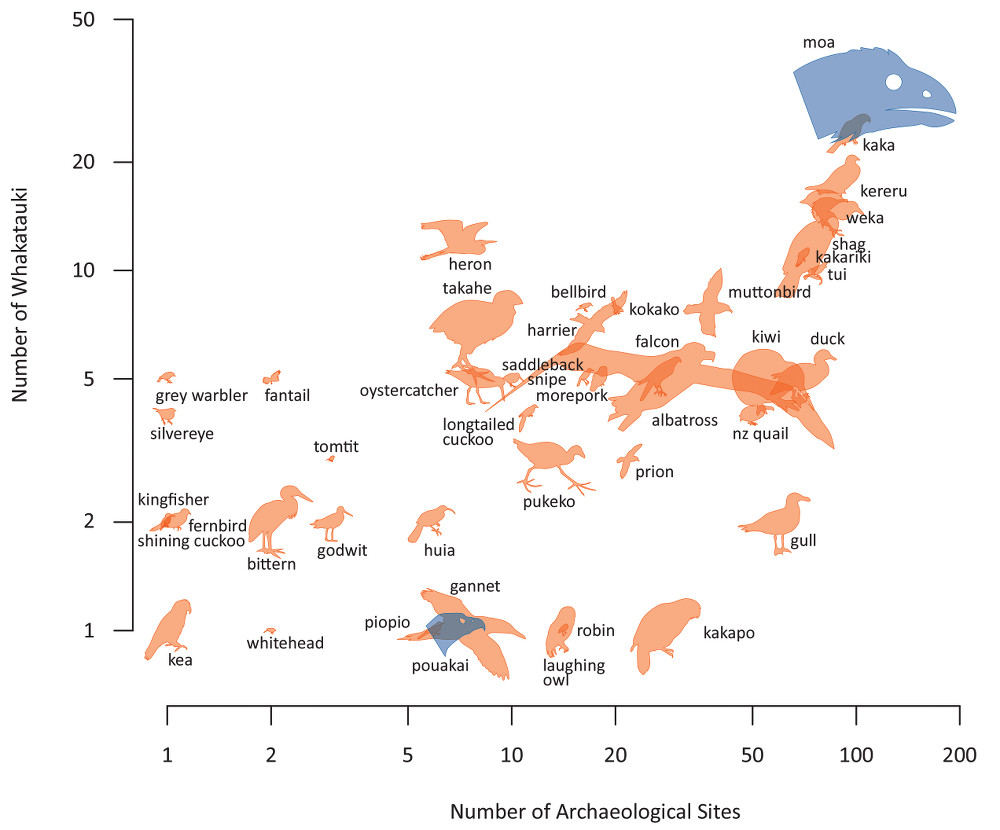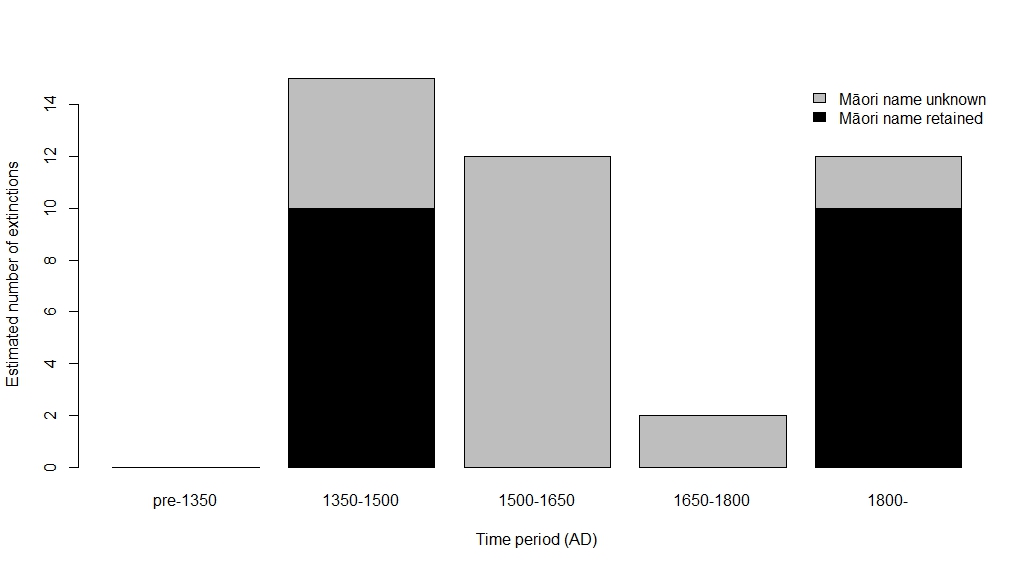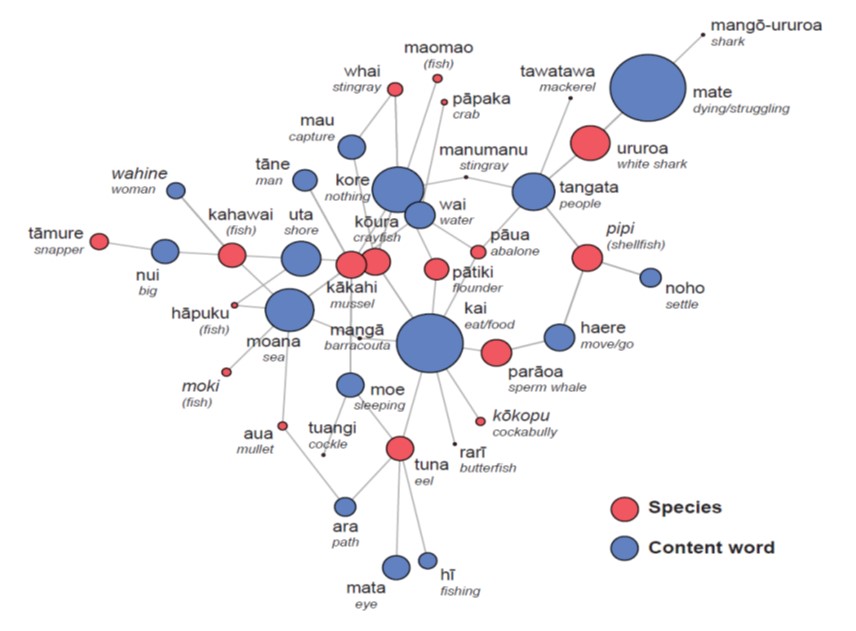Language and biodiversity
I research human – environmental relationships in the context of historical change. In societies with oral rather than written traditions, ecological and historical information is embedded in many different forms of oral tradition (Wehi 2009, Wehi et al. 2019), and it is critical that we consider narratives written in Indigenous languages such as Māori.
Our latest research considers regional nuances in the Indigenous ecological knowledge expressed in plant names, focusing on one New Zealand forest species (Carpodetus serratus) that is known variously as putaputawētā, punawētā, kaiwētā and piripiriwhata. We hope that this work will be coming out in the journal Conservation Science and Practice shortly.
This complements our work on Māori bird names, and the numerous rich ecological understandings embedded in Indigenous bird names, from seasonality to sexual dimorphism (Wehi et al. 2019). Regional language variants may emphasise different aspects of ecosystem functioning, and offer insight into past species distributions.
During my PhD, I began considering Indigenous ecological knowledge of a highly valued weaving plant, Phormium tenax or harakeke, that is embedded in one particular form of Māori oral tradition, whakataukī. This work with oral traditions has developed into a major research strand that I and my collaborators have now been working on for 10 years. We continue to examine whakataukī to explore what they can tell us about past ecosystems, future ecological restoration, and Māori relationships with the rest of nature.
Extinction of keystone fauna has been important for shaping ecological and social thought in Māori society, and suggests a similar role in other early societies that lived through megafaunal extinction events.

 In In recent time, most avian extinctions on mainland New Zealand occurred either prior to AD 1500 (within 150 years of Māori arrival), or after European arrival, post-1800 AD. With bats as the only living terrestrial mammal, birds were critical to both ecosystems and human survival. Key avian extinction periods occurred shortly after Māori and European settlement periods.
In In recent time, most avian extinctions on mainland New Zealand occurred either prior to AD 1500 (within 150 years of Māori arrival), or after European arrival, post-1800 AD. With bats as the only living terrestrial mammal, birds were critical to both ecosystems and human survival. Key avian extinction periods occurred shortly after Māori and European settlement periods.
Language, culture and biodiversity are closely linked, as seen in our whakataukī research, where species extinction leads to extinction of experience and language. Māori names for birds that became extinct prior to European arrival are now unknown, with the exception of words for moa and pouākai. This loss contrasts with the retention of names for birds that became extinct after European arrival, and highlights one way that language and knowledge of biodiversity are intertwined.
In work on marine and freshwater species, we created a network of high frequency species names and content words appearing in individual whakataukī (e.g. kai and kōura, food and crayfish; kai and pātiki, food and flounder). The resulting network (shown below), indicates clear connections between sharks, and death (mate) with humans (tangata), indicating a strong relationship between their behaviour (i.e. struggling to death, persistence, perseverance) and desired human attributes in times of confrontation.
 The proximity of fish species and the network to moana (ocean) and uta (towards the shore) provide examples of spatial proximity, and the different habitats where these species may be found.
The proximity of fish species and the network to moana (ocean) and uta (towards the shore) provide examples of spatial proximity, and the different habitats where these species may be found.
Our team is currently exploring representations of introduced species, and especially plants, in oral Māori tradition.
References
- Wehi PM, Brownstein G, Morgan-Richards M (forthcoming). Indigenous knowledge of an insect-plant relationship.
- Wehi PM, Carter L, Harawira TW, Fitzgerald G, Lloyd K, Whaanga H, MacLeod C 2019. Enhancing awareness and adoption of cultural values through use of Māori bird names in science communication and reporting. New Zealand Journal of Ecology 43 (3): 3387. 10.20417/nzjecol.43.35
- Wehi PM, Cox MP, Roa T & Whaanga H 2018. Human perceptions revealed by linguistic analysis of Māori oral traditions. Human Ecology 2018: 1–10. 10.1007/s10745-018-0004-0
- Whaanga H, Wehi PM, Cox MP, Roa T & Kusabs I 2018. Māori oral traditions record and convey indigenous knowledge of marine and freshwater resources. NZ Journal of Marine and Freshwater Research 52: 487–496. 10.1080/00288330.2018.1488749
- Wehi P, Cox M, Roa T, Whaanga H 2013. Marine resources in Māori oral tradition: he kai moana, he kai mā te hinengaro. Journal of Marine and Island Cultures 2(2): 59–68. 10.1016/j.imic.2013.11.006
- Wehi PM 2009. Indigenous ancestral sayings contribute to modern conservation partnerships: examples using Phormium tenax. Ecological Applications 19:267–275. 10.1890/07-1693.1.
- Wehi PM, Whaanga H & Roa T 2009. Missing in translation: Māori language and oral tradition in scientific analyses of traditional ecological knowledge. Journal of the Royal Society of New Zealand 39: 139-149. 10.1080/03014220909510580